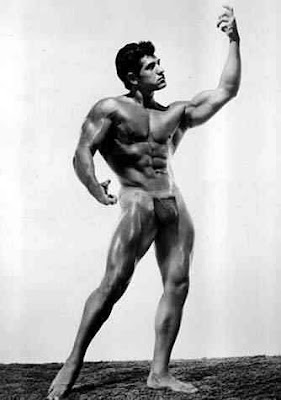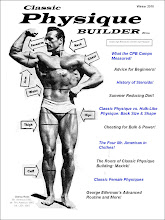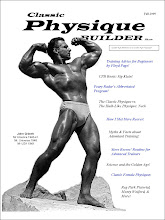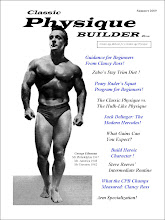
(Photo above: Classic Physique Builder Reg Lewis - Mr. Northern California 1955, Mr. Pacific Coast 1956)
One of the keys to building a classic physique is in understanding what we call the Classic Physique Building (CPB) Principles. These are the principles of weight training that were discovered, developed, and named in the Golden Age of Classic Physique Building (the 1940s and 50s).
These principles were discovered, largely, by trial and error by the Golden Age champs. Joe Weider was responsible for giving many of these principles "catchy names" and promoting them to his readers. So many of them became known as the "Weider Principles." These names now form some of the modern "vocabulary" of weight training. So the CPB Principles (as we call them) include the "Weider" principles and others (named by others or named by us) that were utilized during the Golden Age.
Although it may sound too basic, it is best to start off with discussing the CPB Principle of Progressive Resistance. This is one of the most important and foundational principles of building a classic physique. The principle is this - muscles grow in response to progressive resistance. In other words, a muscle will get larger in response to lifting progressively heavier weights over time.
As basic as this is, we are continually surprised in the gym when we see people - day in and day out, for weeks and weeks on end - continue to perform the same exercise using the same weight and same number of sets! We recall seeing a poor fellow who is always in the gym, always does bench presses with 20 lbs on an Olympic bar, and always does the same number of reps and sets! Of course, this fellow never grows! His physique never changes. His problem is that, although he is persistent (which is good), he doesn't understand the CPB Principle of Progressive Resistance.
So if you want to increase your muscle mass (for any body part) for building a classic physique, you must strive to continually push your weights (poundages) up in your exercises. For example, if a workout routine calls for doing 2 sets of 8 reps, what does that mean? It means you should pick a weight that allows you to just barely complete the 8th rep (in other words, doing a 9th rep would not be possible) on your first set. Then after resting for a minute, you might be able to do 6-7 reps on your second set with the same weight. If this happens, then you've picked the correct weight. Now, after a few workouts, you get stronger and find that you can easily complete 8 reps on both sets! This means, you've gotten stronger AND a little bigger (even if you can't measure the size increase yet). So now, you MUST increase your weight! How much? Increase it so that, like before, you can barely complete your 8th rep on your first set and 6-7 reps on your second. Then repeat the same process (after a few workouts when you can easily complete 8 reps on both sets, increase the weight again).
Understanding and using this principle correctly will be your first and foundational key to muscle growth (whether you are younger or older)! It is not the only CPB principle - but it is, perhaps, the most important one to understand at the beginning of your training. And regardless of what other principles you use, this one should be the cornerstone of your training if you want to gain size.
So check your workout routine. Have you been performing the same exercises, with the same weights and same reps, and feeling like you are getting nowhere? If so, perhaps you now understand why. Just take a week lay off, adjust your workout routine to include the CPB Principle of Progressive Resistance and then start up again! Assuming that you are not overtraining your muscles (with too many exercises, too many sets, or too many workouts per week), and that you are eating and resting properly, you should start to see some gains!
Stay tuned for future posts on CPB Principles!
- CPB







9 comments:
This is again a great post.
But which warm up do you recommend when training, say only 2 sets of 8 reps in a certain exercise.
Or is there no need for counting a warm up set as to the general workout?
Thanks CPB great Posts!
Hi Ibrahim,
Great Question! We don't believe in warm-up sets with substantial weights because, in our view, that will detract from your all out effort on your scheduled sets (and can also end up in overtraining the muscle).
Our practice is to warm up for each exercise by going through the movement of that exercise with an empty bar (whether with barbells or dumbbells) for 1 set (if you don't have adjustable DBs, then you can use very light DBs instead). In addition to this, we might do a couple of reps with 50% weight on that exercise. The idea is not so much to warm up the muscle, but to make sure that the joints involved are thoroughly warmed up to avoid injury.
That is enough to for us to thoroughly warm up the joints, yet keep the muscles fresh for on all out effort on our scheduled sets.
We note that everyone is a little different, so you should always do a warm-up that makes you feel safe in avoiding possible injuries.
All the best,
- CPB
Here i have great vids of Jack Lalanne on how to gain weight and a sample meal plan which is consisting of 3 meals, too.
http://www.youtube.com/watch?v=R-vjSOtuvDI
http://www.youtube.com/watch?v=MpjDg2q_nuk&feature=related
http://www.youtube.com/watch?v=VuW3RfWJ1H0
Sorry i have so many questions:)
What do you guys think about expander training. I read that Reg Park was a great stranpuller and John Grimek also trained with expanders. I heard that Joe Weider sold an expander course.
I really can´t wait for the next interesting posts.
Hi Ibrahim,
Thanks for the info on Jack LaLanne!
As for expander training, these chest expanders were promoted by Weider (and others) during the Golden Age and you can find many Golden Age champs, like Clancy Ross and others, in adds for these expanders.
These kind of exercise devices were money makers for Weider and others (remember, they were promoted largely in the days before supplements - after that, supplements became the money makers).
Our take on expanders is this. For the regular person on the go (travelling), who just wants to do some kind of exercise to maintain general muscle tone, then they are fine. (Although these days, good hotels always seem to have fitness centers!).
But for classic physique builders who need to build muscle mass - forget it. They aren't going to do that.
Thanks again for your contribution to CPB Blog!
All the best,
- CPB
Another question:
What do you think about the light weightlifting principle like Mark Berry or Bob Hoffman recommended?
I love your site, it feels like home to me. Really i check it out every day.
Thanks for the work you put in this site.
I hope you doing good so far.
I found another Steve Reeves Drink,
i don´t know if he was using it but here it is:
Blend the following ingredients until smooth. Makes one serving.
12 oz. Fresh Squeezed Orange Juice
2 Tablespoons of Wheat Germ
2 Tablespoons Bee Pollen
2 Tablespoons Knox Gelatin Mix
2 Tablespoons Raw Honey
1 Medium Ripe Banana
Best Regards
Hi Ibrahim,
The Reeves drink you posted sounds like his "energy drink" to us. Later in life, sometimes he would drink his energy drink (as we call it) in the morning, workout, then lie down for a half hour, then get up and have his "power" (protein) drink.
Regarding Hoffman's light weightlifting principle, if you mean his inclusion of weightlifting (as in competitive weightlifting) movements in some of the York courses (actually course #3 was a weightlifting course), then our take on it is this:
If a person is interested in weightlifting, then these movements/exercises are fine. By practicing these, you will improve in your ability in these specific lifts. However, these type of exercises, in our view, are not necessary (and do not greatly contribute) to building a classic physique.
In the early days of the Golden Age, weightlifting and physique building were "joined at the hip." Both Hoffman and Weider were weightlifters who then promoted physique building to varying degrees (Weider more so than Hoffman). However, by the end of the Golden Age, these two disciplines were largely separated.
Hoffman's vision of the "perfect man" always included an aspect of functional strength (as reflected in ability in weightlifting movements and gymnastics). To him, a good physique was more or less a "side effect" of strength training. Weider's vision was more "physique centered." He was the first to really promote physique building for its own sake. To him, strength was a "side effect" of phyique building (this is our generalization).
So that being said, we think that if weightlifting is something that a classic physique builder is interested in, then by all means, they can include that in their training. But these specific weightlifting movements are not necessary for building a classic physique.
All the best,
CPB
what the heck happened to Reg Lewis - he is on your side bar powered by YouTube - he is 73 years old which I feel isn't old, but he looks like he never did anything in his life to keep in shape - I know a ton of guys in there 70's & 80's and they don't look that bad - And to top it off he is making a pitch for a health supplement for sight - he should look in the mirror and go on a diet - what a embarasment for the Classic Physique guys - Up to his unforunate death Reeves looked great
Post a Comment